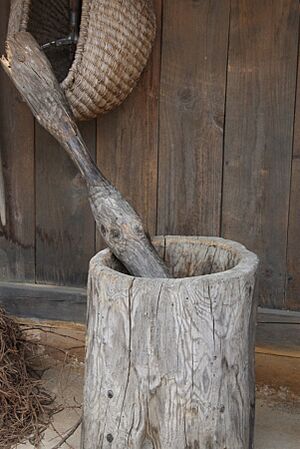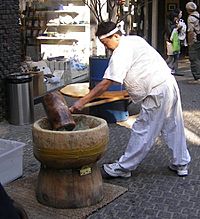Jeolgu facts for kids
| Jeolgu and gongi | |

Wooden jeolgu (mortar) and gongi (pestle)
|
|
Quick facts for kids Korean name |
|
|---|---|
| Hangul |
절구
|
| Revised Romanization | jeolgu |
| McCune–Reischauer | chŏlgu |
| IPA | [tɕʌl.ɡu] |
| Hangul |
공이
|
| Revised Romanization | gongi |
| McCune–Reischauer | kong'i |
| IPA | [koŋ.i] |
Have you ever wondered how people used to grind grains or make delicious rice cakes before modern machines? In Korea, they had special tools called Jeolgu (pronounced: jul-goo) and Gongi (pronounced: gong-ee). These traditional tools are like a super old-school mortar and pestle set. They were perfect for pounding all sorts of things, from grains to sticky tteok (Korean rice cakes).
What are Jeolgu and Gongi?
Jeolgu is a special bowl-shaped container. It's where you put the grains or other food items you want to pound. Think of it as the "bowl" part of a mortar and pestle.
Gongi is the tool used for pounding. It's like the "pestle" part. You use the gongi to crush and grind things inside the jeolgu. Sometimes, gongi can also mean a stamper used in a larger machine called a stamp mill.
How They Are Used
The main job of jeolgu and gongi is to pound things. This was super important for preparing food in old Korea.
- Grinding Grains: People used them to turn grains like rice or barley into flour. This flour was then used to make bread, noodles, or other dishes.
- Making Tteok: One of their most famous uses was making tteok, which are chewy Korean rice cakes. Freshly steamed rice would be put into the jeolgu and pounded with the gongi until it became a smooth, sticky dough. This dough was then shaped into various kinds of tteok.
- Crushing Herbs: They could also be used to crush herbs or other ingredients for traditional medicines or cooking.
Materials They Are Made From
Jeolgu and gongi were made from different materials, depending on what they were used for and what was available.
- Wood: Many were made from strong timber. Wooden sets were often lighter and good for pounding softer items.
- Stone: Stone jeolgu and gongi were very heavy and durable. They were perfect for grinding hard grains or for long-term use.
- Iron: Sometimes, these tools were made from iron, especially for tasks that needed extra strength and durability.
These traditional tools show how people in the past used simple, strong designs to prepare their food every day. Even today, you might see them used in special ceremonies or for making traditional tteok by hand!
Gallery
-
Pounding tteok (rice cake) in jeolgu (mortar) with tteokme (mallet)


